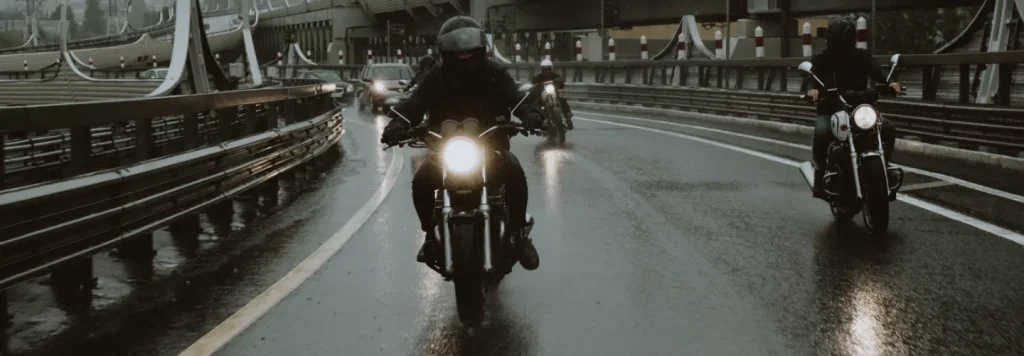From pre-ride inspections to breakdown coverage, here are a few things to do to keep yourself safe on your motorcycle.
As temperatures begin to rise, so do the number of motorcycles on the road. It’s important to remember that this mode of transportation is inherently more dangerous than operating a passenger vehicle. According to the National Highway Transportation Safety Administration, 2019 saw motorcyclist fatalities occur nearly 29 times more per mile driven compared to passenger cars.
With that in mind, and with the help of Travelers Insurance, here are four safety tips for motorcyclists to keep in mind before they hit the road.
1. Take a Motorcycle Safety Course
Even if you already have a license to operate a motorcycle, it’s probably a good idea to take a motorcycle safety course to learn new skills or sharpen existing ones. In addition to a basic operator course aimed at beginners, there are safety courses you can explore from organizations like the Motorcycle Safety Foundation® (MSF), which offers a variety of instruction modules that include, for example, topics such as riding in groups on the road or alone on the trails.
2. Keep Your Gear in Good Condition
A mechanical failure while riding can lead to a serious crash. To help minimize the possibility of equipment or systems malfunction, thoroughly inspect your bike before every ride. Your pre-ride inspection should confirm that headlamps, turn signals, and brake lights are functioning properly.
The MSF uses the acronym TCLOCS4 (tires, controls, lights, oil, chassis, stands) to help motorcyclists remember which areas typically should be inspected prior to riding. Checking tires for wear, cuts, or bulges, for example, may help prevent a potentially troublesome blowout on the road. Maintaining proper fluid levels can help preserve the mechanical integrity of a bike and also can help prevent a sudden engine problem that could cause you to take a spill or have a mishap on the road.
And it’s more than just the bike itself; wearing the right motorcycle gear can help keep you safe on the road. Some states require riders to wear helmets, which are always recommended, as is some sort of eye protection to help protect against debris that may be kicked up from other vehicles. Then there’s leather riding gear and boots. In the event you lose control of your bike and strike the road surface, the heavy outerwear is designed to help protect against road rash and may help to lessen the severity of muscular or skeletal injuries.
3. Stay Observant and Visible
A major cause of motorcycle collisions is that drivers of cars or trucks fail to see bikes on the roadway. With a compact physical profile, motorcyclists must take every possible precaution to help make sure they are visible to other drivers. Your pre-ride inspection should confirm that headlamps, turn signals, and brake lights are functioning properly. High-visibility clothing helps riders be seen during the day, while reflective materials on bike frames or outerwear can help to increase visibility at night.
Defensive motorcycle operation also comes into play. Riders should constantly scan ahead and from side to side to observe any possible hazards that may cause a collision or upset. When it comes to other vehicles, a motorcyclist should always assume that another driver cannot see his or her bike. As a motorcycle operator, that means you should be at safe braking distances and controllable speeds when you are maneuvering in blind spots or in proximity to cars.
4. Have Motorcycle Insurance
Not only should you take care and maintain sound driving habits, but you should also be sure to have an active insurance policy. In addition to being required in most states, motorcycle insurance coverage helps protect you from financial liability on multiple fronts if you are ever in an accident. Some coverage options include:
- Liability Coverage – If you cause damage to another person or their property during a motorcycle accident, liability coverage helps you pay for the resulting costs to cover repairs and other bills.
- Guest Passenger Coverage – Passengers who ride on your motorcycle with you might not have good insurance coverage themselves, putting them at risk if they are injured while on the road. Your insurance coverage can help them pay for medical bills and care for their injuries, if necessary, helping them avoid financial distress in the event of an accident.
- Medical Payments & Personal Injury Protection – Insurance can help pay for your own medical expenses and provide personal injury protection in the event of a crash for even more coverage.
- Collision & Comprehensive Coverage – While property liability covers the costs of repairing or replacing property that belongs to other people, collision and comprehensive coverage helps pay for damage done to your own property.
- Breakdown Coverage – Motorcycle repair insurance, sometimes called mechanical breakdown insurance, is an optional type of coverage that pays for certain repairs to your motorcycle. In this way, it is similar to an extended warranty that can help you repair the engine, transmission, and other regular maintenance repairs made at your local repair shop.
If you’re eagerly awaiting to hit the open road on your bike this season, be sure to keep yourself safe and protected. If you find yourself ever unsure of your motorcycle insurance coverage or status, reach out to The Feltner Group and see how we can help you secure the best possible rate for the coverage you need.
